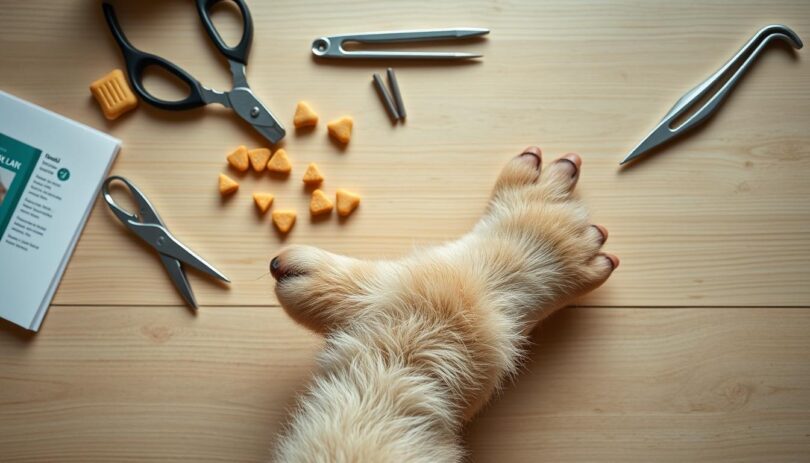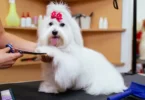Did you know only 20% of dog owners trim their dog's nails regularly? This shows a big gap in pet care that affects your dog's health and movement. Clipping dog nails is key to pet grooming, but many find it scary.
Keeping your dog's nails short is more than just looks. Long nails can lead to deformed feet, less grip, and tendon injuries. Groomers know how vital nail care is. But, with the right tips, you can do it at home with confidence.
This guide will help you learn to clip your dog's nails safely. It turns a stressful task into a special moment with your pet. We'll cover the basics and show you how to trim your dog's nails without hurting them.
Learning to groom your dog's nails saves money and keeps them healthy. This guide is for new dog owners and those who want to get better at nail trimming. It's all here for you.
Understanding the Importance of Dog Nail Clipping
Dog paw care is not just about looks. It's key to your dog's health and how they move. If you ignore your dog's nails, it can hurt their comfort and health.
Health Risks of Overgrown Nails
Long nails can harm dogs a lot. They put too much pressure on paws and legs. This can make dogs walk differently, hurt their joints, and increase injury risk.
Dogs with long nails might feel pain like wearing bad shoes all the time.
Benefits of Regular Nail Maintenance
Keeping your dog's nails trimmed is good for them. Doing it every 2-4 weeks helps prevent walking problems, like in older dogs with arthritis. It also lowers the chance of painful nails and saves money on vet bills.
Good nail care helps your dog move naturally and avoids long-term damage.
Signs Your Dog Needs a Nail Trim
Knowing when your dog needs a nail trim is important. Look for signs like clicking sounds on hard floors, nails that are too long, or trouble walking. Dogs that don't move much or walk on smooth surfaces need more nail care to stay healthy.
Tools You'll Need for Dog Nail Clipping
Getting ready for dog nail trimming means having the right tools. It's important to pick equipment that keeps you and your pet safe and comfortable.
Dog nail trimming is more than just grabbing any clipper. Professional groomers say knowing the different tools helps make the process easier and less stressful.
Best Types of Nail Clippers for Dogs
The right dog nail clipper depends on your dog's size and nail thickness. Scissor-style clippers are best for small to medium dogs. Guillotine-style clippers are better for larger dogs with thicker nails. Some people like ergonomic designs for better grip and precision.
Alternative Tools: Grinders vs. Clippers
A dog nail grinder is a modern choice instead of clippers. These electric tools slowly file down nails, reducing the risk of cutting the quick. Grinders are great for dogs with thick or dark nails. They're also good for pets that don't like traditional nail clipping.
Essential Safety Gear for You and Your Dog
Safety is key during nail trimming. Keep styptic powder ready to stop bleeding, and wear protective gloves. A non-slip mat and treats can help keep your dog calm. Remember, being patient and positive makes nail trimming better for everyone.
Preparing Your Dog for Nail Clipping
Safe dog nail cutting begins with a calm and stress-free space for your pet. Pet grooming, like nail trimming, can be tough. Many dogs get anxious, making prep key for a good grooming session.
Early training is vital in lowering stress during nail trimming. Vets say to start paw handling early, when dogs are puppies. This makes them more at ease with touch and less fearful of grooming.
Creating a Calm Atmosphere
Find a quiet, cozy spot for nail clipping. The room should be warm and free from distractions. Your dog needs to feel safe and relaxed. Speak softly and reassuringly to keep them calm.
Desensitization for Nervous Dogs
Introduce nail clippers slowly. Let your dog sniff and explore the clippers first. Gently touch their paws without cutting, rewarding them with treats and praise. This helps them overcome fear and link nail care to positive experiences.
Positive Reinforcement Techniques
Treats are your best friend in safe dog nail cutting. Use treats your dog loves. Give them treats before, during, and after trimming to make it a positive experience. Start with just one or two nails at a time, with breaks in between to avoid overwhelming them.
Remember, patience is essential in pet grooming. Some dogs may need weeks or months to get used to nail trimming. Be consistent, gentle, and always put your dog's emotional well-being first.
Step-by-Step Guide to Clipping Dog Nails
Dog nail clipping can be tough for many pet owners. About 70% find it stressful for both them and their dogs. Knowing the right way to do it is key for safe nail cutting and good paw care.
Positioning Your Dog for Success
Comfort is essential when getting ready for nail trimming. Pick a quiet, well-lit spot where your dog feels calm. Some dogs like sitting on a non-slip surface or being held by someone.
The aim is to make a peaceful setting. This helps reduce your dog's stress during nail clipping.
Identifying the Quick: Avoiding Injury
The quick has blood vessels and nerves, so it's important to spot it before cutting. In dogs with clear nails, you can see the quick in about 50% of cases. For dogs with black nails, it's harder to find.
Use good lighting and be careful not to cut too close to the quick.
The Clipping Process Explained
When trimming, hold your dog's paw firmly but gently. Place your thumb on the pad and your forefinger on the skin above the nail. Push the pad back to extend the nail.
Trim at a 45-degree angle to match the nail's natural shape. This helps avoid cutting into the quick.
Pro tip: Keep styptic powder ready in case of bleeding. Remember, regular practice and positive feedback can lower your dog's anxiety by up to 40%. Give treats and praise to make nail trimming a better experience for both of you.
Post-Clipping Care for Your Dog's Nails
After trimming your dog's nails, they need extra care to stay comfortable and healthy. Pet grooming is more than just clipping. It's also about the care after.
Inspecting for Nail Damage
Check each nail for splits or uneven edges after trimming. Dog paw care needs a gentle touch and careful eyes. Look for any signs of bad cuts or rough spots that might hurt when walking.
Cleaning and Moisturizing Paw Pads
Use a soft, damp cloth to clean your dog's paw pads after trimming. Apply a pet-safe paw balm to keep them moisturized and safe. This is key to keeping their nails healthy and preventing dryness.
Monitoring Your Dog's Reaction
Watch how your dog moves and acts after their nails are trimmed. Look for limping, not wanting to walk, or signs of pain. If they seem uncomfortable, talk to your vet. Giving them treats can make nail care a good thing.
Remember, getting better at nail care takes time. Most dogs need trims every 3-4 weeks, based on how active they are and how fast their nails grow. Dogs that spend more time outside might need less trimming because their nails wear down naturally.
Common Questions About Dog Nail Clipping
Dog nail trimming can be tough for many pet owners. Knowing how to care for your dog's nails is key to their health and happiness. Here are answers to common questions about dog nail care.
How Often Should I Clip My Dog's Nails?
Dogs usually need their nails trimmed every 3 to 4 weeks. How often depends on how active your dog is and where they play. Dogs that walk a lot on hard ground might not need as much trimming.
But indoor dogs or those who don't move as much might need more regular trims.
What to Do If I Cut the Quick?
Oops, cutting the quick can bleed. Keep styptic powder ready to stop the bleeding fast. If it keeps bleeding or is a lot, call your vet.
Preventing quick cuts means trimming carefully and knowing your dog's nails well.
Can I Clip My Dog's Nails During Winter?
Winter doesn't mean you can skip dog nail care. Indoor dogs might need more trims when it's cold and they're less active. Don't forget about dewclaws, which don't wear down naturally.
Regular nail checks are important all year round.
Remember, regular nail care stops problems like walking issues, joint pain, and nail splits. If you're unsure, ask a groomer or vet for advice on your dog's nail needs.
Alternatives to Clipping Your Dog's Nails
Dog owners often find clipping nails tough. But, there are many ways to keep your pet's nails healthy. These methods make grooming easier and less scary for your dog.
Nail Grinding: A Modern Approach
A dog nail grinder is a modern tool for trimming nails. It gives you control and avoids cutting the quick. Start with short sessions to help your dog get used to the sound and feel.
Professional Grooming Services
Professional dog pedicures are great for those unsure about nail care. Groomers know how to handle different dogs and trim nails safely. They make the process stress-free for your pet.
Natural Nail Care Solutions
Walking on hard surfaces like concrete can wear down your dog's nails. Scratching posts and cardboard boards also help. These options keep nails short and satisfy your dog's natural behaviors. They work well with traditional grooming methods to keep paws healthy.
Tips for a Stress-Free Nail Clipping Experience
Safe dog nail cutting doesn't have to be scary for you or your dog. Building a positive grooming routine takes time and planning. The goal is to turn nail trimming into a fun bonding time for both of you.
Experts say to set a regular schedule for nail care. Start by clipping nails slowly, using treats and praise to make it positive. Short, regular sessions are better than long, rare ones. Choose a quiet spot where your dog feels safe and calm.
Look out for signs of stress like shaking, pulling away, or heavy breathing. These mean your dog might be feeling anxious. If your dog gets too stressed, stop and give them treats for staying calm. Some dogs like peanut butter on a lick mat or a gentle massage while you trim their nails.
Every dog is different in how they handle nail care. Groomers advise making each session positive by keeping it short and rewarding. Never scold your dog for being nervous. With regular practice and patience, nail trimming can become a calm part of your routine.











Leave a Comment